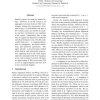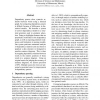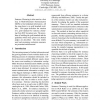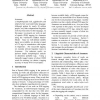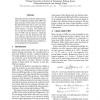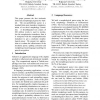96
Voted
ACL
2009
14 years 10 months ago
2009
Large scale efforts are underway to create dependency treebanks and parsers for Hindi and other Indian languages. Hindi, being a morphologically rich, flexible word order language...
82
Voted
ACL
2009
14 years 10 months ago
2009
Parallel corpora are made by human beings. However, as an MT system is an aggregation of state-of-the-art NLP technologies without any intervention of human beings, it is unavoida...
93
Voted
ACL
2009
14 years 10 months ago
2009
The use of figurative language is ubiquitous in natural language texts and it is a serious bottleneck in automatic text understanding. We address the problem of interpretation of ...
119
click to vote
ACL
2009
14 years 10 months ago
2009
Dependency parsers show syntactic relations between words using a directed graph, but comparing dependency parsers is difficult because of differences in theoretical models. We de...
105
click to vote
ACL
2009
14 years 10 months ago
2009
Sentence Clustering is often used as a first step in Multi-Document Summarization (MDS) to find redundant information. All the same there is no gold standard available. This paper...
ACL
2009
14 years 10 months ago
2009
Assamese is a morphologically rich, agglutinative and relatively free word order Indic language. Although spoken by nearly 30 million people, very little computational linguistic ...
90
Voted
ACL
2009
14 years 10 months ago
2009
This paper presents an efficient inference algorithm of conditional random fields (CRFs) for large-scale data. Our key idea is to decompose the output label state into an active s...
112
Voted
ACL
2009
14 years 10 months ago
2009
This paper presents the first stochastic finite-state morphological parser for Turkish. The non-probabilistic parser is a standard finite-state transducer implementation of two-le...
ACL
2009
14 years 10 months ago
2009
Tree-based statistical machine translation models have made significant progress in recent years, especially when replacing 1-best trees with packed forests. However, as the parsi...
125
click to vote
ACL
2009
14 years 10 months ago
2009
Recently, there is a growing interest in working with tree-structured data in different applications and domains such as computational biology and natural language processing. Mor...

